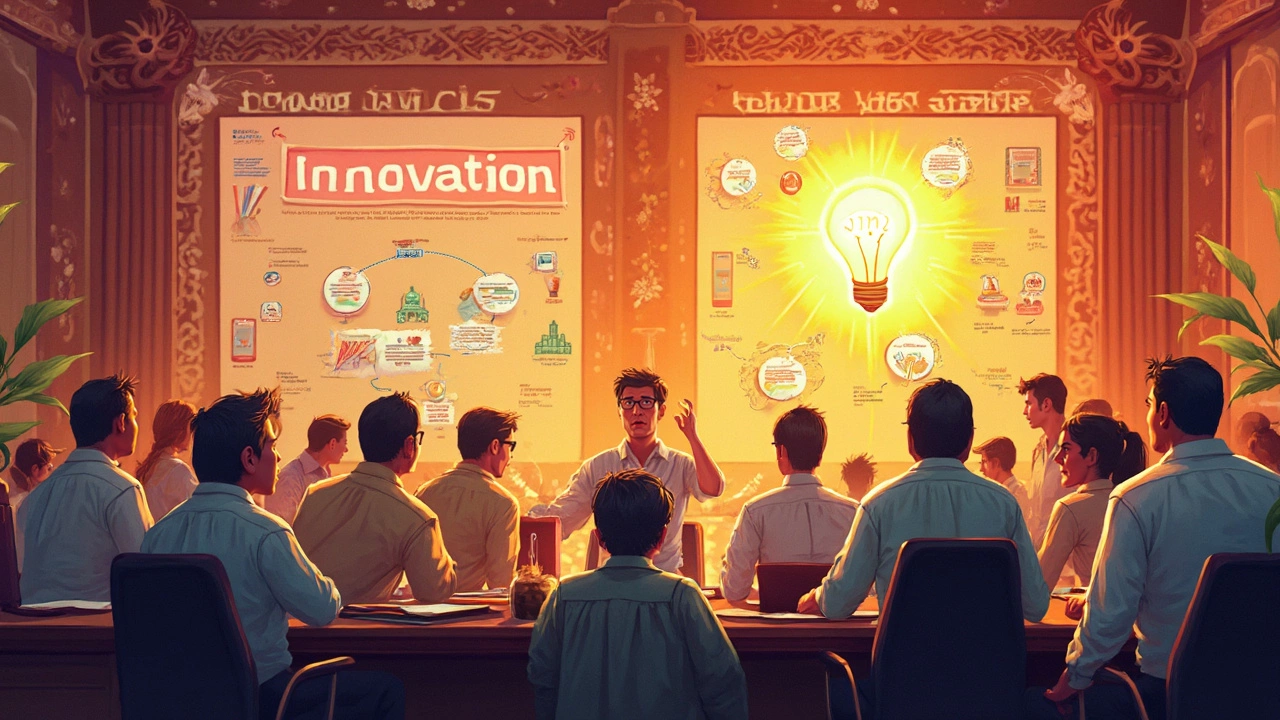Difference Between Change and Innovation in Policy
 Mar, 24 2025
Mar, 24 2025
Change and innovation are words often tossed around, but they're not the same thing, especially when it comes to policy. Change is broad – it’s like upgrading our old phone; we do it out of necessity or updates. Innovation, though, is like switching to a smartphone for the first time; it's transformative and opens up new possibilities.
Think about it: change may adjust what already exists, while innovation introduces something new. Innovation propels us forward, drives progress, and ideally leads to better solutions in policy. To make sense of these concepts, especially in policy, we should look at how they operate in real life.
- Defining Change and Innovation
- Real-world Examples in Policy
- Driving Forces Behind Innovation
- Challenges and Considerations
- Practical Tips for Policy Makers
Defining Change and Innovation
When we talk about change, it's about any adjustment or alteration. It could be minor, like fixing a bug in software, or significant, like overhauling healthcare policy. Change is necessary, but it's not always groundbreaking.
On the other hand, innovation refers to introducing something fresh and substantial. It's like stepping into a new era. Consider the introduction of electric vehicles – that wasn't just a change in car design; it was a whole new way of thinking about transportation.
According to a study from the OECD, “Innovation Policy is focused on promoting the emergence and diffusion of those technologies, processes, institutions, and capabilities that can contribute to economic growth and social well-being.” That’s a mouthful, but in simpler terms, it means pushing for new ideas that can make a big impact.
“Innovation distinguishes between a leader and a follower.” – Steve Jobs
In the realm of policy, embracing innovation can mean adopting new technologies or ideas that can lead to better outcomes. It’s about thinking ahead and being ready to forge new paths.
Change vs. Innovation in Policy
Imagine a government deciding to update traffic rules to accommodate rising cyclist numbers in a city. That's change. Now, picture the same government implementing autonomous buses to revolutionize public transport. That's innovation. Policy-wise, one steps into the future while the other might just be keeping pace.
Understanding these differences is crucial. Policymakers who recognize when to utilize either change or innovation can shape a more resilient and competitive environment.
Real-world Examples in Policy
When we talk about policy, distinguishing between change and innovation is crucial. Policies around the world have exemplified both, sometimes within the same program, affecting the trajectory of their direct impacts. Let's look at some examples.
Healthcare Reforms
Consider the healthcare policies in various nations. The UK's National Health Service (NHS) has undergone numerous changes over the years, such as budget adjustments or staffing restructures. But innovation was introduced with telemedicine, which allowed patients to consult doctors online, improving accessibility dramatically during the pandemic.
Education Policies
In education, the shift to online classrooms showcases both concepts. The common change was moving classes online. But the innovation came in when schools adopted interactive learning platforms that didn't just replicate classroom environments but transformed the learning experience entirely.
Environmental Initiatives
Let's touch on environmental policy. Many cities have upgraded their waste management systems, which is a change. However, some places, like San Francisco, have implemented zero-waste initiatives that represent true innovation — these policies create circular economies and significantly change how society approaches waste.
Tapping into these examples, it's clear how policy can inspire both change and innovation. Each has its role, and blending them effectively is key to progress.

Driving Forces Behind Innovation
What really pushes innovation in policy? It's not just about having a cool idea; several factors come into play. Let's break down some of the main ones.
Technology Advancements
Tech developments are a massive driver. The rise of AI and machine learning is revolutionizing sectors like healthcare and transportation. It's not about minor tweaks; we're talking major leaps that require policies to catch up and adapt.
Global Competition
Nations are in a constant race to outdo each other. This competition encourages change and innovation in policy. Countries invest in research and development to stay ahead, often resulting in innovative policy changes.
Consumer Demands
People today are more informed and connected than ever. They demand better services and more transparency, pushing policymakers to innovate. Whether it's smoother public transport systems or more efficient healthcare services, consumer expectations drive change.
Environmental Challenges
With climate change being a pressing issue, sustainable policies are becoming necessary. Innovation here is about developing policies that support green technologies and practices.
Real progress often happens when these forces combine. For example, the pressure to reduce carbon emissions has led to innovation in renewable energy policies across the globe.
If you're a policymaker or just someone interested in how the world changes, keeping an eye on these forces can give you a good sense of where we're headed next.
Challenges and Considerations
Diving into change and innovation in policy, there are specific challenges to tackle. One of the main issues is that while everyone loves the idea of innovation, implementing it successfully can be tricky. It often involves overcoming resistance from those who prefer the status quo. People tend to stick to what they know, and this hesitation can slow down progress.
Understanding Resistance
Resistance isn't always negative; sometimes, it's about practical concerns. Policymakers need to align new ideas with existing power structures and regulations. It's crucial to have plans that address these barriers upfront. Strong communication and education about the benefits of innovation can help ease these transitions.
Risk Management
Every innovation comes with risks. Unlike simple change, which might tweak a policy here and there, innovation involves uncharted waters. Policymakers must ask: What if things don't go as planned? Creating a robust risk management framework can mitigate potential pitfalls, allowing innovation to flourish.
Resource Allocation
Policy innovation needs resources, whether it’s time, money, or human capital. Ensuring there's enough investment to support the innovation journey is key. Policymakers must strategically allocate resources to nurture new ideas without neglecting ongoing operations.
Data-Driven Decisions
In today's world, data is more available than ever. Yet, making data-driven decisions can still be a hurdle. The challenge here lies in effectively analyzing the data to support policy innovations. A well-informed approach can help predict outcomes and tailor innovations to meet actual needs.
| Challenge | Solution |
|---|---|
| Resistance | Communication and Education |
| Risk | Risk Management Framework |
| Resources | Strategic Allocation |
| Data | Data-Driven Decisions |
Overall, addressing these challenges is all about being prepared, staying flexible, and having a clear vision. By focusing on these aspects, policymakers can turn potential hurdles into opportunities for genuine innovation.

Practical Tips for Policy Makers
As a policy maker, understanding the distinction between change and innovation is just the starting point. Here are some actionable steps to harness the power of innovation effectively:
1. Embrace a Culture of Innovation
Encourage an organizational culture that values experimentation. This means not just tolerating failures but learning from them to find better solutions. An open mindset is key to driving meaningful innovation.
2. Align with Stakeholder Needs
Improvement isn't just about new ideas; they need to meet the actual needs of your community or stakeholders. Regularly engage with these groups to ensure your policy changes are not only innovative but also relevant and beneficial.
3. Prioritize Research and Development
Invest in R&D to stay ahead of the curve. Staying competitive often means being the first to deploy new technologies or strategies. Take a proactive approach to uncover fresh insights and potential areas for innovation.
4. Foster Collaboration
Partner with other sectors or even international bodies. Cross-border cooperation can bring in diverse perspectives and resources, helping to implement more robust and effective change.
5. Monitor and Evaluate
Policies should be dynamic. Regularly evaluating the impact of new strategies allows you to adjust and improve as necessary. This feedback loop is crucial for sustainable innovation.
With these tips, policy makers can better navigate between simple changes and world-changing innovations. The balance can determine how well a community adapts and prospers in today’s fast-paced world.